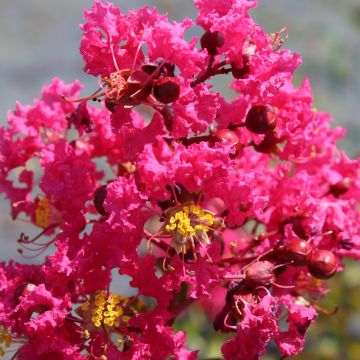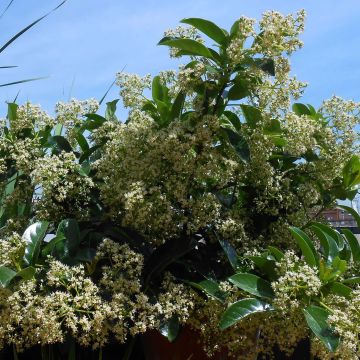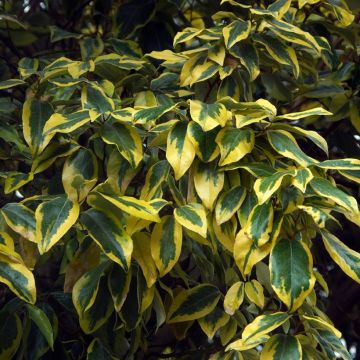

Lagerstroemia indica Yang Tse - Crape Myrtle


Lagerstroemia indica Yang Tse - Crape Myrtle
Lagerstroemia indica Yang Tse - Crape Myrtle
Lagerstroemia indica Yang Tse
Crape Myrtle, Crepe Myrtle, Indian Lilac
The ordered young plant arrived quickly and very well packaged. Unfortunately, as soon as it was unpacked, the plant appeared bare and the young branches were dried out. It wouldn't even have crossed my mind to choose it in a store.
Nicolas T., 31/08/2019
Special offer!
Receive a €20 voucher for any order over €90 (excluding delivery costs, credit notes, and plastic-free options)!
1- Add your favorite plants to your cart.
2- Once you have reached €90, confirm your order (you can even choose the delivery date!).
3- As soon as your order is shipped, you will receive an email containing your voucher code, valid for 3 months (90 days).
Your voucher is unique and can only be used once, for any order with a minimum value of €20, excluding delivery costs.
Can be combined with other current offers, non-divisible and non-refundable.
Home or relay delivery (depending on size and destination)
Schedule delivery date,
and select date in basket
This plant carries a 24 months recovery warranty
More information
We guarantee the quality of our plants for a full growing cycle, and will replace at our expense any plant that fails to recover under normal climatic and planting conditions.
Would this plant suit my garden?
Set up your Plantfit profile →
Description
The Lagerstroemia indica 'Yang Tse' is a very popular variety of Indian Lilac, thanks to its superb early flowering with deep pink carmine, even in northern regions. This vigorous bush, with an upright habit, has beautiful shiny green leaves that turn red in autumn. Its smooth bark is often richly coloured. These bushes like warmth but appreciate a little moisture at their feet in summer to support their flowering. This one, grown in many regions, will make a sensation when planted alone in a small garden, as a lively hedge, or at the heart of a flower bed.
The Lagerstroemia indica 'Yang Tse' belongs to the Lythraceae family. The Lagerstroemia indica, from which it originates, is native to China. The famous cultivar 'Yang Tse' was selected in 1983 at the Demartis nursery in Dordogne. It has been the best-selling variety for the past 50 years. This very vigorous and hardy bush reaches a height of 4 to 5 metres (13 to 16 feet) at maturity, with a spread of about 3 metres (10 feet). Its flowering generally starts in early July and lasts until September. The flowers are characterised by slender pedicels, each bearing five undulate-edged petals that make up this flower. The flowers, with a crepe-like texture, are gathered in large, dense, and heavy panicles, forming a pyramid shape at the tips of the branches. In the case of 'Yang Tse', the abundant flowering is a deep carmine to intense magenta colour. The coriaceous and deciduous foliage is a shiny dark green. It consists of small ovate leaves that take on a pretty coppery red hue in autumn, depending on the climate. Finally, and to end on a high note, its bark is truly beautiful, smooth, beige with brown-red stripes, peeling off in coloured patches (cinnamon, faded red, old rose, cream).
Indian Lilacs traditionally grace gardens in the Southwest. Preferring the humid and warm South Atlantic to the dry and windy Mediterranean, it is a small tree that deserves to be acclimated in the colder areas of our country, by carefully choosing the variety and its location. Its hardiness and vigour allow for this. It looks best when planted alone, close to the house, where you can fully enjoy its generosity. It will make a good impression in a shrub bed, a flowering hedge, or emerging from a mound of perennials. Create a flower bed like a bouquet, with Nepeta, Salvia sclarea or jamensis, and Aster laevis. In autumn, it accompanies cotinus and deciduous euonymus, which are as colourful as it is. In a large pot on the terrace, it puts on a show while summer flowering fades. Imagine a weaving of thyme (Thymus hirsutus, longicaulis, nitens), oregano, and silver baskets to dress the base of its trunk, emphasise the beauty of its bark, and reflect its beautiful flowering.
NB: We would like to point out that this tree produces fruits that have a narcotic effect if ingested.
Lagerstroemia indica Yang Tse - Crape Myrtle in pictures




Plant habit
Flowering
Foliage
Botanical data
Lagerstroemia
indica
Yang Tse
Lythraceae
Crape Myrtle, Crepe Myrtle, Indian Lilac
Cultivar or hybrid
Other Lagerstroemia - Crape Myrtle
View all →Planting and care
The Lagerstroemia indica 'Yang Tse' should be planted in spring in well-drained and fertile soil, in a warm and sunny location. Every year, enrich the soil around the base with decomposed manure and leaf compost. Prune it back in spring, leaving only two or three buds per branch. Treat against powdery mildew. In cold regions, wrap the entire branches in winter protection cloth throughout the winter.
Planting period
Intended location
Care
Planting & care advice
-
, onOrder confirmed
Reply from on Promesse de fleurs
Similar products
Haven't found what you were looking for?
Hardiness is the lowest winter temperature a plant can endure without suffering serious damage or even dying. However, hardiness is affected by location (a sheltered area, such as a patio), protection (winter cover) and soil type (hardiness is improved by well-drained soil).

Photo Sharing Terms & Conditions
In order to encourage gardeners to interact and share their experiences, Promesse de fleurs offers various media enabling content to be uploaded onto its Site - in particular via the ‘Photo sharing’ module.
The User agrees to refrain from:
- Posting any content that is illegal, prejudicial, insulting, racist, inciteful to hatred, revisionist, contrary to public decency, that infringes on privacy or on the privacy rights of third parties, in particular the publicity rights of persons and goods, intellectual property rights, or the right to privacy.
- Submitting content on behalf of a third party;
- Impersonate the identity of a third party and/or publish any personal information about a third party;
In general, the User undertakes to refrain from any unethical behaviour.
All Content (in particular text, comments, files, images, photos, videos, creative works, etc.), which may be subject to property or intellectual property rights, image or other private rights, shall remain the property of the User, subject to the limited rights granted by the terms of the licence granted by Promesse de fleurs as stated below. Users are at liberty to publish or not to publish such Content on the Site, notably via the ‘Photo Sharing’ facility, and accept that this Content shall be made public and freely accessible, notably on the Internet.
Users further acknowledge, undertake to have ,and guarantee that they hold all necessary rights and permissions to publish such material on the Site, in particular with regard to the legislation in force pertaining to any privacy, property, intellectual property, image, or contractual rights, or rights of any other nature. By publishing such Content on the Site, Users acknowledge accepting full liability as publishers of the Content within the meaning of the law, and grant Promesse de fleurs, free of charge, an inclusive, worldwide licence for the said Content for the entire duration of its publication, including all reproduction, representation, up/downloading, displaying, performing, transmission, and storage rights.
Users also grant permission for their name to be linked to the Content and accept that this link may not always be made available.
By engaging in posting material, Users consent to their Content becoming automatically accessible on the Internet, in particular on other sites and/or blogs and/or web pages of the Promesse de fleurs site, including in particular social pages and the Promesse de fleurs catalogue.
Users may secure the removal of entrusted content free of charge by issuing a simple request via our contact form.
The flowering period indicated on our website applies to countries and regions located in USDA zone 8 (France, the United Kingdom, Ireland, the Netherlands, etc.)
It will vary according to where you live:
- In zones 9 to 10 (Italy, Spain, Greece, etc.), flowering will occur about 2 to 4 weeks earlier.
- In zones 6 to 7 (Germany, Poland, Slovenia, and lower mountainous regions), flowering will be delayed by 2 to 3 weeks.
- In zone 5 (Central Europe, Scandinavia), blooming will be delayed by 3 to 5 weeks.
In temperate climates, pruning of spring-flowering shrubs (forsythia, spireas, etc.) should be done just after flowering.
Pruning of summer-flowering shrubs (Indian Lilac, Perovskia, etc.) can be done in winter or spring.
In cold regions as well as with frost-sensitive plants, avoid pruning too early when severe frosts may still occur.
The planting period indicated on our website applies to countries and regions located in USDA zone 8 (France, United Kingdom, Ireland, Netherlands).
It will vary according to where you live:
- In Mediterranean zones (Marseille, Madrid, Milan, etc.), autumn and winter are the best planting periods.
- In continental zones (Strasbourg, Munich, Vienna, etc.), delay planting by 2 to 3 weeks in spring and bring it forward by 2 to 4 weeks in autumn.
- In mountainous regions (the Alps, Pyrenees, Carpathians, etc.), it is best to plant in late spring (May-June) or late summer (August-September).
The harvesting period indicated on our website applies to countries and regions in USDA zone 8 (France, England, Ireland, the Netherlands).
In colder areas (Scandinavia, Poland, Austria...) fruit and vegetable harvests are likely to be delayed by 3-4 weeks.
In warmer areas (Italy, Spain, Greece, etc.), harvesting will probably take place earlier, depending on weather conditions.
The sowing periods indicated on our website apply to countries and regions within USDA Zone 8 (France, UK, Ireland, Netherlands).
In colder areas (Scandinavia, Poland, Austria...), delay any outdoor sowing by 3-4 weeks, or sow under glass.
In warmer climes (Italy, Spain, Greece, etc.), bring outdoor sowing forward by a few weeks.



























































